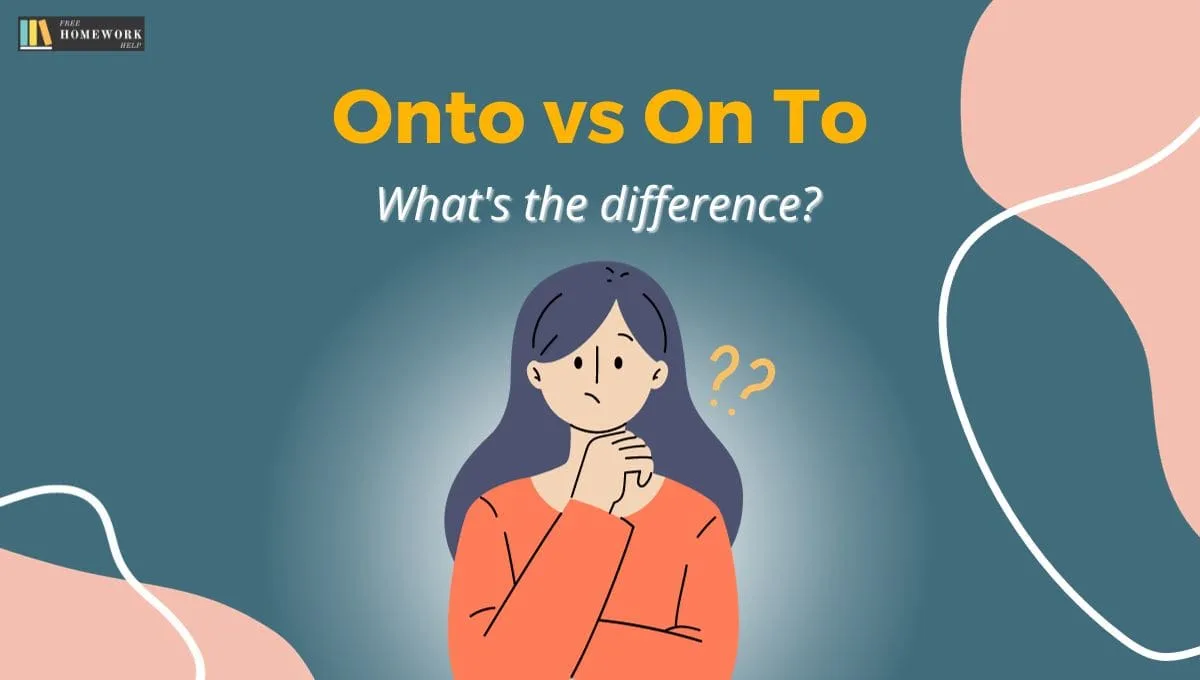There is often confusion between Onto vs On To. In this article, we will explain the difference between Onto and On to. “Onto” indicates the movement or location of something, while “On to” indicates the awareness or continuity of an action. We will find out when and how they are commonly used, and provide example sentences that show them in use. Understanding these subtle differences can increase the accuracy of your language.
When to Use Onto vs On To
The single word onto is commonly used as a preposition that can mean “on,” or “at some position.”It is used when something or someone is physically or metaphorically moving or changing into a new state or condition.
Example: She stepped onto the stage with confidence.
In this sentence, “onto” is used to indicate movement into a new position.
The separate words on and to often appear alongside each other in sentences that use idiomatic phrasal verbs or infinitives.”On to” consists of the preposition “on” followed by the preposition “to.” It is used when both “on” and “to” are needed to convey their meanings in the sentence.
Example: He placed the book on the table.
In this sentence, “on to” is used when both “on” and “to” are relevant to convey the intended meaning.
Definition
“Onto” and “on to” are two different phrases in English, and they are used in slightly different contexts:
Onto: This is a single preposition that indicates motion or direction, often meaning that something is being moved toward something, either physically or figuratively. It is used to show a change in status or goal.
Example 1: She jumped onto the bed.
Example 2: The company is moving towards a new phase of development.
On to: “On” and “to” are separate words in a sentence. They serve different grammatical purposes in a sentence and they do not function as a single prepositional phrase. “On to” refers to physically being on top of something and then moving to a different place or topic.
Example 1: She put the book on the table and then went to the kitchen.
Example 2: During the conversation he moved on to a new topic.
Onto vs On to Examples
“Onto” and “on to” are often confused, but they have different meanings and uses. Here are some examples to explain the difference:
Examples of Onto
- She climbed onto the roof to fix the antenna.
- The cat jumped onto the table to catch the mouse.
- The keys fell onto the floor with a loud jingle.
- He stumbled and fell onto the sidewalk.
- The team is determined to hold onto their lead in the competition.
- He quickly caught onto the new software program’s features.
- They shifted the responsibility onto the project manager.
- Please pass the plate of rice onto the next table.
- The baby held onto her mother’s hand tightly.
These are just a few examples of how “onto” can be used in English sentences to express different meanings and ideas depending on the context.
Examples of On to
“On to” is a phrase used in English that can have different meanings depending on the context. Here are some examples of how “on to” can be used:
- He held on to his dreams and never gave up.
- Let’s move on to the next item on the agenda.
- Please pass the documents on to the manager.
- Despite the challenges, he held on to his dreams.
- The detective was quick to catch on to the suspect’s lies.
- Sarah is on to her dreams of becoming a successful writer.

In these examples, “on to” is used when “on” and “to” are separate words. It often denotes a different meaning, such as understanding something, moving forward, or transitioning to a new topic or task.
Difference Between Onto Vs On To
It’s important to note that Onto Vs On have distinct meanings and usage, so using the correct one in a sentence is essential for clear communication. Here are the differences between Onto and On To in the English language:

Read Also: Into vs Onto : Meaning, Difference with 10 Easy Examples
FAQ
What is the difference between onto and on to one?
“On to” is a verb phrase or a phrasal verb, involving a combination of two words. Onto is a preposition that means “on top of, to a position on, upon.”
Is it holding onto or on to?
In English “holding onto” and “on to” are both correct, but they are used in slightly different contexts.
“Holding onto” is used when you want to express the action of physically holding something.
“Holding On to” is used when you want to express the idea of moving forward, literally or figuratively.
Where is onto used?
“Onto” is used as a preposition to describe the direction of an object moving toward a surface.
What are the synonyms of onto?
Synonyms for “onto” in the English language are:
Upon
On top of
On
Over
Upon the surface of
Up to
Against
Towards
To
Toward
What is the opposite of onto?
The opposite of “onto” in English is “off.”
Conclusion
The difference between “onto” vs “on to” is important in English. “Onto” is a preposition indicating motion or location.”On to” separates “on” and “to” and is used when the words have different meanings. Correct usage enhances clarity and communication in written and spoken language.
